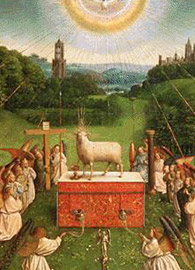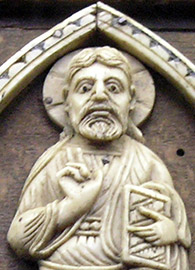Revelation Week 3
Thanksgiving to our Triune God (Revelation 4:1–11)
By Rob Wall
Seattle Pacific University Paul T. Walls Professor of Scripture and Wesleyan Studies
Read this week’s Scripture: Revelation 4:1–11
17:08
Podcast read by Carla M. Wall

 Enlarge
Enlarge
The world traveler preparing to visit a strange country typically consults the notes of those who have journeyed there already and who know well the must-sees and the do-nots. In my case, I’m interested in dollars — so an experienced traveler’s notes of cheap places to see and lodge are crucial elements of my prep work for visiting a new city. Lots of folks think the same way: my search of Amazon.com returned over 150,000 books cued by “travel guide”! We are citizens of a global village, and the ease of travel and availability of travel guides make our trips to new places a routine of modern living. Revelation is a travel guide for readers who are about to visit a very strange place built by a prophet’s visionary experiences. John has been commissioned by the “one like a Human One” (the exalted Jesus) (Revelation 1:13) to write these experiences down (1:19) — as a kind of apocalyptic travel guide! — for the churches to read aloud and hear so they can prepare for their own future trip to kingdom come.
But the prophet must travel there first. Revelation resumes its first person narrative when John observes that “a door” has been opened to him (4:1) and hears a voice sounding a trumpet’s note to summon him into heaven. Heaven is home to God, and so we anticipate that the prophet is there to observe God at work.
John Visits Heaven and Reports Back to Us
This majestic voice belongs to the exalted Jesus, who had earlier told John that he would receive visions of “what must take place after this” (4:1; cf. 1:19). John’s prophetic work is about to begin! Of course, prophets get to this heavenly otherworld “in the Spirit” (4:2), not by a Boeing Dreamliner. The prophet’s ecstatic experience is his mode of transportation. This phrase, “in the Spirit,” which the CEB translates “in a Spirit-inspired trance,” is repeated four times in Revelation (1:10; 4:2; 17:3; 21:10). In every case it marks off a new vision that John is about to receive, always prefaced by instructions and a travel itinerary from Jesus, before John is transported by the Spirit to a new place (on Patmos, in heaven, into the wilderness, on a mountaintop) for another apocalyptic light and sound show about what has taken place, is now taking place, and will soon take place. More importantly, this phrase reminds us that the true source of Revelation is not from “the prophet’s own understanding of things [but is] led by the Holy Spirit spoke from God” (2 Peter 1:20–21).
Reminder: the “heaven” into which John is here transported is not the future “new heaven” (Revelation 21:1) of a completely renewed creation, of which John will take a Cook’s tour “in the Spirit” (21:10). That heaven will come with the exalted Lamb’s return to earth to complete his messianic mission. The heaven that John now visits is the first heaven, whose landscape has been radically altered with the arrival of the exalted Son (see 12:1–12). What John now observes and hears, and then writes down for the churches through Revelation 16, envisions heaven’s perspective of the multiple effects on today’s earth that “must take place after this” (4:1) — i.e., the dying and rising of God’s Lamb, our Lord.
Reminder #2: the literary form John uses to write down what he observes and hears is that of a pastoral letter. Revelation 4 is an epistolary thanksgiving. Take a quick look at your favorite Pauline letter. Unless you choose Galatians, which an upset Paul wrote refusing to thank God for his Galatian brothers and sisters, you will find following Paul’s greetings a word of thanks offered to God for the recipients of his letter.
A Letter of Thanksgiving, Description, and Symbolism
The function of these thanksgivings within a pastoral letter is twofold. First, generally God is thanked because of the faith and life being formed by God’s grace in the congregation addressed. On occasion, however, such as in his letter to the Ephesians, Paul thanks the triune God for being God. We observe that this form of prayerful thanksgiving is borrowed from Jewish worship, and so intends to address the issues that occasioned the writing of the letter in an atmosphere of worship and praise. The thanksgiving of Revelation is like that of Ephesians: it is a doxology of praise to the triune God, which not only locates any reading of Revelation within the posture of worship and praise but also introduces readers to the church’s core beliefs about God that underwrite everything else written.
Second, epistolary thanksgivings always hint at the problem at hand, which then Paul addresses in the main body of his letter. Typically Paul makes his concerns known as the petition of his daily prayers for the congregation being addressed. In the case of Revelation, John hints at what lies ahead in the book by the lyrics of the spectacular doxologies that center John’s vision of God’s heavenly throne room.
Indeed, what John first observes once he passes through the opened door is no game of thrones! The war has already been waged and won. He sees a nameless but bejeweled someone seated on heaven’s throne (4:2) and begins to describe the array of special effects that surround the figure he sees. [Author’s Note 1] Of course, the prophet has in hand his own travel guide, Israel’s Scripture (our Old Testament), which helps him understand and write down what he observes and hears. Visions of God’s heavenly throne are found throughout the Old Testament (see 1 Kings 22:19–23; Isaiah 6; Ezekiel 1; Daniel 7) and also in a variety of Jewish writings that circulated widely in the earliest church and are alluded to by the New Testament writers (e.g., 1 Enoch; cf. 2 Corinthians 12:1–4).
But what is clear is that John says more about what surrounds the throne than about the one who occupies it! This stunning throne is the thing that should attract our attention, at least for the moment: it symbolizes rule. And the galactic lightning storm and peals of thunder, like those that announced God’s arrival on Sinai to call Israel to task (Exodus 19:16–19), indicate that the one who occupies it is holy and wholly sovereign. The numerology John uses is precise — the twenty-four elders, who themselves are enthroned around the center throne, and the sevenfold torch and spirit (Revelation 4:4–5) — in order to sound notes of encouragement for God’s people (12 tribes + 12 apostles = 24 people), whom the heavenly elders represent before the throne. They are those for whom God’s fiery Spirit bears witness of God’s victory over death. [Author’s Note 2]
Symbolism of the Four Living Creatures

 Enlarge
Enlarge
John’s eye will turn back to the elders in time to witness their worship and hear their doxology (4:10–11), but for now his attention is drawn to “four living creatures” (4:6) who also encircle the throne and whose worship of the one seated there is coordinated with the elders in perpetual praise. Combining features that John recognizes from the biblical cherubim of Ezekiel 1 and seraphim of Isaiah 6, these four creatures are noteworthy by their location: they are at the center of the room, standing right next to the throne. What they do and say helps us understand the throne and the one seated on it.
But first, they are “living creatures,” not angels (4:6). They represent God’s creation. They are each full of eyes, front and back, and so miss nothing of all that happens on earth. In fact, representatives from every nook and cranny of creation, both inanimate (e.g., jasper, carnelian, crystal; 4:3, 6) and animate, surround the throne in worship of the one who sits there. Among them are these four creatures that the prophet recognizes from Ezekiel 1:10; the number four symbolizes all creation — every corner of it and everything upon, under, and above it. [Author’s Note 3] The face of each suggests it is the celestial double for a particular family of creature (e.g, birds by the eagle-faced creature) in a way that echoes the creation story (see Genesis 1:24–26). All creation is in play in heaven as on earth, in worship and adoration of the sovereign Creator.
The two doxologies of their heavenly worship (Revelation 4:8, 11) introduce the big-ticket beliefs about God that do most of Revelation’s theological heavy lifting: they introduce us to the one seated on creation’s throne who alone is worthy of creation’s unending praise. Even today our church liturgies use these two hymns of cosmic praise to prepare worshipers for hearing God’s Word and receiving the Lord’s Supper. The truth about God that John hears confessed in his heavenly vision is of a God whose active presence (“glory”) fills the whole earth (Isaiah 6:3). [Author’s Note 4]
The threefold repetition of “holy” (4:8) invokes the beat of worshiping our triune God. God’s holiness determines the living God’s continual activity: the past tense of the holy God (“who was”) and the present tense of this holy God (who “is”), who will remain holy in God’s future activity (who “is to come”). But how should we understand this eternal exercise of God’s holiness?
God’s Present Holiness and Future Victory
Scripture’s idea of holiness cannot be reduced to a simple definition, whether it means the absolute purity or the wholly otherness of God. While hearing the creature’s affirmation, John would almost certainly have the deep logic of the Lord’s Prayer (Matthew 6:7–15) in mind. Jesus teaches his disciples to frame their various petitions (for food, for forgiveness, for help in time of spiritual need) by who God is: God is “our Father in heaven” whose name is “hallowed,” or holy (Matthew 6:9). On this basis Jesus anticipates that the heavenly reign of this holy God will come to earth, and once here what is real in heaven will also become real on earth. These are the spatial images of God’s future victory! They shape the posture and politics of prayer.
After hearing creation’s doxology in Revelation 4, especially after listening in on the Lord’s address of the seven churches in Revelation 2–3, it may well strike the reader that God’s name is hardly “hallowed” even by most Christians! Nor does it seem that the booty of God’s victory over evil, which we claim has already been waged and won by the risen Jesus, is experienced by only the faithful few in Smyrna and Philadelphia! In John’s day, Rome’s kingdom seems to control earth’s fortunes, and in our day names have changed but the perception has not: the name of God is not hallowed, nor is God’s triumph over unrighteousness yet fully come to earth.
But it is precisely because the battle has already been waged and won that in John’s vision of the throne God is worshiped but unheard and unseen; God’s holiness is not paraded for all to see but rather is affirmed by others. Nor does God demand all this attention. Even God’s revelation and judgments are carried by others. This is a God quite comfortable to exist as the recipient of deserving but undemanding affection, and who doesn’t seem terribly bothered by the current fuss and foment caused by evil and death whose rule over earth has never been the match of its Creator. Nor should God’s people worry: this is an eternal God whose past and future is of a piece with God’s holy presence.
God: Creator of All, Savior of All
The second doxology of the twenty-four elders (4:11) is decisive in doing what every epistolary thanksgiving must: it rehearses what the letter’s main body will next take up in full dress. This doxology is again a sentence in two parts. The first part elaborates on who God is: not only is the triune God absolutely holy, God is worthy (i.e., deserving [Author’s Note 5]) to receive creation’s “glory and honor and power.” The use of “power” strikes me as odd since “thanks” is used in 4:9. But the context here is creation; the recognition of God’s “power” over every other creaturely power is based upon God’s activity as “maker of all that is seen and unseen.” To elevate any creature as more powerful than its Creator is both idolatrous and idiotic.
The second part of this doxology is causal and makes this clear: God is due this recognition because God has done creation. But because God has created and given purpose to all things, whether non-human or human, it follows that God is savior of all these things (see 21:5). Creation and salvation are flipsides of the same coin that belongs to the one and only God. And so here is the grand storyline of this book: God has a plan to save creation, which the exalted Lamb (see Revelation 5) has already brought to realization. In saving creation, the Creator restores every creature, whether human or non-human, according to the Creator’s intended purpose for each.
Questions for Further Reflection
- What difference does it make that it is the exalted Jesus in view here?
- Recall three Old Testament images that appear here in the description of heaven.
- What can we know about God from the action around the throne?
- What is a Christian’s natural response to this vision of the throne?
<<Previous Lectio Back to Revelation Next Lectio>>

This work is licensed under a Creative Commons License.





The study is challenging, and I pray that the Holy Spirit will empower me to achieve my goal in Jesus’ name.